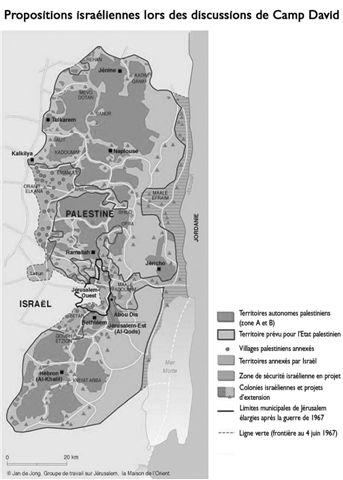Pas rancunier, ou alors pas fier, le négociateur israélien Yossi Beilin ne demandera pas de droits d’auteur au Premier ministre Ehud Barak, lorsque celui-ci inventera la sinistre plaisanterie de « l’offre généreuse » refusée par les Palestiniens, et qui aurait conduit à la débâcle des négociations israélo-palestiniennes de l’été 2000.
Comme le révèlera par la suite Robert Malley, conseiller du président américain Clinton de 1998 à 2001, l’offre en question, pas du tout généreuse, fut élaborée par les dirigeants israéliens dès le mois de novembre 1995, sous le nom de « plan Beilin-Mazen ».
Ce plan laisse intactes TOUTES les colonies. Les négociateurs israéliens exigent que 130 d’entre elles, les plus gros blocs représentant 150.000 colons soient annexés à Israël. Les 50 restantes seront « incluses » dans le futur Etat palestinien. Elles auraient d’emblée lézardé cet Etat, puisqu’il n’est évidemment pas question pour le sionisme que des Juifs deviennent citoyens d’un Etat palestinien. Les colonies incluses auraient donc toujours leurs propres routes, leurs avant-postes, et leurs soldats (israéliens, évidemment) pour les « défendre ». En outre, l’armée israélienne conservera la vallée du Jourdain, et le contrôle de la frontière avec la Jordanie. Dès 1995, les dirigeants israéliens ont donc prévu de parquer les Palestiniens de Cisjordanie dans quatre enclaves séparées, couvrant moins de la moitié de la Cisjordanie.
Le Premier ministre Yitzhak Rabin, mort le 4 novembre 1995 sous les balles d’un sioniste radical, a évidemment participé à l’élaboration du plan, note Tanya Reinhart dans son livre « Détruire la Palestine ». Elle souligne que si Israël avait réellement souhaité parvenir à un accord, Rabin aurait au moins fait le geste d’évacuer la minuscule colonie d’Hébron et ses 400 colons, notamment après l’attentat commis contre des fidèles musulmans en 1994 dans la mosquée d’Ibrahim. En outre, l’armée israélienne restera en place dans la vallée du Jourdain, et contrôlera toutes les frontières du futur Etat palestinien avec ses voisins arabes. Le tout avec la bénédiction des Etats-Unis, arbitre « impartial » de ces négociations.
Mais le plus incroyable reste le formidable tour de passe-passe concernant la question de Jérusalem. L’expression « division de Jérusalem » qui était régulièrement employée pendant tout le processus d’Oslo, avait fait croire au monde entier que Jérusalem-Est reviendrait à l’Etat palestinien. En fait, la capitale de l’Etat palestinien devait bien s’appeler Al-Qods (le nom arabe de Jérusalem qui signifie « ville sainte »), mais elle se situerait… dans la banlieue de Jérusalem, à Abou-Dis !

par CAPJPO-EuroPalestine
ENGLISH TEXT———————
1995
The « Generous Offer »
Not spiteful, or again, not proud, the Israeli negotiator Yossi Beilin did not ask Prime minister Ehud Barak for authors rights when he invented the menacing joke of a « generous offer, » refused by the Palestinians, and which led to the Israeli-Palestinian negotiating debacle oif the summer of 2000.
As revealed by Robert Malley, counselor to US President Clinton from 1998 to 2001, the offer in question, not at all generous, had been elaborated by Israeli leaders, beginning in November 1995, under the name of the « Plan Beilin-Mazen. »
That plan leaves in tact ALL the settlements. Israeli negotiators insisted that the 130 largest of them, representing 150,000 settlers, be annexed to Israel. The other 50 would be « included » in the future Palestinian state. From the beginning their effect would have been to split up the that state, because there would be no question for Zionists that Jews would become citizens of a Palestinian state. The included settlements would continue to have their own streets, military posts and soldiers (obviously Israeli) to defend them. Among otherthings, the Israeli army would hold on to the Jordan valley, and would control the frontier with Jordan. From 1995, then, Israeli leaders had planned to place West Bank Palestinians in four separated enclaves, covering less than half of the West Bank territory.
In her book, Israel/Palestine: How to End the War of 1948, Tanya Reinhart noted that Prime Minister Yitzhak Rabin, killed on November 4, 1995 by the bullets of a radical Zionist, had obviously participated in the elaboration of the plan. She emphasized that if Israel had truly wanted to arrive at an agreement, Rabin would have at least made the gesture of evacuating the the 400 sellers of the tiny settlement of Hebron, especially after the 1994 attack on a group of religious Muslims in the Mosque of Ibrahim. In stead, the Israeli army remained on the Jordan valley, continued to control all of the frontiers of the future Palestinian state with Jordan and its Arab neighbors. All of this with the benediction of the United States, the « impartial » arbitrator of the negotiations.
But the most incredible aspect of all this was the amazing slight of hand concerning the question of Jerusalem. The expression « division of Jerusalem » which was regularly used during the entire Oslo process gave everyone the impression that East Jerusalem would be returned to the Palestinian state. In fact, the capital of the Palestinian State should be called Al-Qods (the Arab name for Jerusalem, which means « Holy City »), but it is situated in the Jerusalem suburb of Abou-Dis!

By CAPJPO-EuroPalestine


